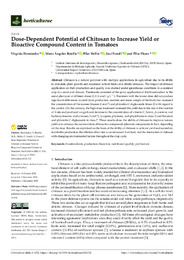Por favor, use este identificador para citar o enlazar este ítem:
https://hdl.handle.net/11000/32440Registro completo de metadatos
| Campo DC | Valor | Lengua/Idioma |
|---|---|---|
| dc.contributor.author | Hernández, Virginia | - |
| dc.contributor.author | Botella, M. Ángeles | - |
| dc.contributor.author | Hellín, Pilar | - |
| dc.contributor.author | Fenoll, José | - |
| dc.contributor.author | Flores, Pilar | - |
| dc.contributor.other | Departamentos de la UMH::Biología Aplicada | es_ES |
| dc.date.accessioned | 2024-07-12T08:29:52Z | - |
| dc.date.available | 2024-07-12T08:29:52Z | - |
| dc.date.created | 2022-12-06 | - |
| dc.identifier.citation | Horticulturae 2022, 8(12), 1152 | es_ES |
| dc.identifier.issn | 2311-7524 | - |
| dc.identifier.uri | https://hdl.handle.net/11000/32440 | - |
| dc.description.abstract | Chitosan is a natural polymer with multiple applications in agriculture due to its ability to stimulate plant growth and resistance to both biotic and abiotic stressors. The impact of chitosan application on fruit production and quality was studied under greenhouse conditions in a summer crop in a semi-arid climate. Treatments consisted of the spray application of this biostimulant to the aerial plant part at different doses (0, 0.1, and 1 g L1). Treatment with the lowest dose did not produce significant differences in yield (total production, number, and mean weight of the fruit), but increased the concentration of flavanones (trusses 2 and 7) and phloretin-C-diglucoside (truss 2) with regard to the control. On the contrary, the high-dose treatment increased the yield due to the rise in the number of fruits and produced a significant decrease in the concentration of vitamin C, lutein, b-carotene, and hydroxycinnamic acids (trusses 2 and 7); lycopene, phytoene, and phytofluene in truss 2; and flavanols and phloretin-C-diglucoside in truss 7. These results show the ability of chitosan to improve tomato yield or to enhance the accumulation of bioactive compounds (phenolic compounds) in fruit, depending on the dose. Results are explained on the basis of the ability of chitosan to activate yield and secondary metabolite production, the dilution effect due to an increased fruit load, and the interaction of chitosan with changing environmental factors throughout the crop cycle. | es_ES |
| dc.format | application/pdf | es_ES |
| dc.format.extent | 11 | es_ES |
| dc.language.iso | eng | es_ES |
| dc.publisher | MDPI | es_ES |
| dc.rights | info:eu-repo/semantics/openAccess | es_ES |
| dc.rights | Attribution-NonCommercial-NoDerivatives 4.0 Internacional | * |
| dc.rights.uri | http://creativecommons.org/licenses/by-nc-nd/4.0/ | * |
| dc.subject | biostimulants | es_ES |
| dc.subject | production | es_ES |
| dc.subject | bioactive | es_ES |
| dc.subject | nutritional quality | es_ES |
| dc.subject | pre-harvest | es_ES |
| dc.subject.other | CDU::5 - Ciencias puras y naturales::57 - Biología | es_ES |
| dc.title | Dose-Dependent Potential of Chitosan to Increase Yield or Bioactive Compound Content in Tomatoes | es_ES |
| dc.type | info:eu-repo/semantics/article | es_ES |
| dc.relation.publisherversion | https://doi.org/10.3390/horticulturae8121152 | es_ES |

Ver/Abrir:
horticulturae-08-01152.pdf
446,01 kB
Adobe PDF
Compartir:
 La licencia se describe como: Atribución-NonComercial-NoDerivada 4.0 Internacional.
La licencia se describe como: Atribución-NonComercial-NoDerivada 4.0 Internacional.
.png)